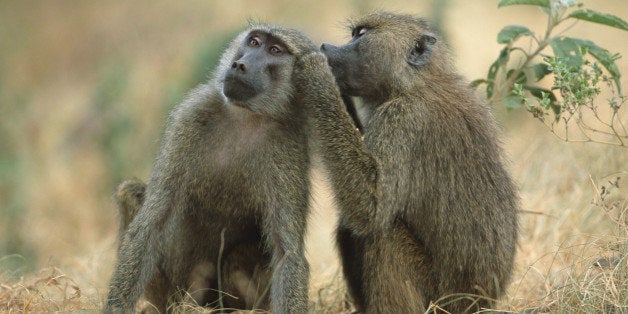
As humankind has evolved, we've built cities and computers, probed into the far reaches of our galaxy and beyond, cured diseases, and developed thousands of different languages and dialects with which to communicate with each other.
These momentous achievements were made possible by the human capacity for "cumulative culture" -- the ability to build up knowledge over generations. As Sir Isaac Newton described his own formulation of the laws of motion and universal gravitation, "If I have seen further, it is by standing upon the shoulders of giants."
There has been some debate over whether or not this ability is uniquely human. But a new study from the French National Center for Scientific Research (CNRS) and the University of Edinburgh has found that baboons share some capacity to build up, transmit and make use of small changes in their collective culture over the course of generations.
The researchers studied groups of baboons living at the CNRS Primatology Center in Rousset, France. The baboons had access to a touch-screen "memory game" that had been designed specifically for the study. To play the game, the baboons briefly viewed a screen that displayed a 16-square grid, four of which were red and 12 white. Then, the image was replaced by the same grid, but this time composed only of white squares. The baboons were then prompted to touch the four squares that were previously red.
The first part of the experiment consisted of a task-learning period in which the position of the four red squares was randomized, so the baboons could determine the goal and strategy of the game. In the second part of the study, baboons were responsible for conveying information about the task to one another, akin to a visual form of the game "telephone": A baboon's response (which squares he touched on the screen) was used to create the next grid pattern that the next baboon would memorize and reproduce. This went on for 12 generations of baboons.
The baboons who performed in the "transmission chain" of knowledge performed better than a control group of randomly tested baboons -- their success rate on the memory game (determined by correct memorization of three of the four squares) increased from 80 percent to over 95 percent over the generations. The researchers observed all three of the necessary components that define cumulative cultural evolution: progressive increase in performance over time, emergence of systematic structures, and "lineage specificity," meaning knowledge shared specifically within the group.
"This study shows that, like humans, baboons have the ability to transmit and accumulate changes over 'cultural generations' and that these incremental changes, which may differ depending on the chain, become structured and more efficient," the study's press release notes.
The discovery joins a body of research demonstrating baboon's impressive cognitive skills. A 2001 study found baboons to be the first non-human, non-ape animals capable of abstract thought, while 2012 research showed that baboons are able to take the first step towards reading by learning to spot real words.

